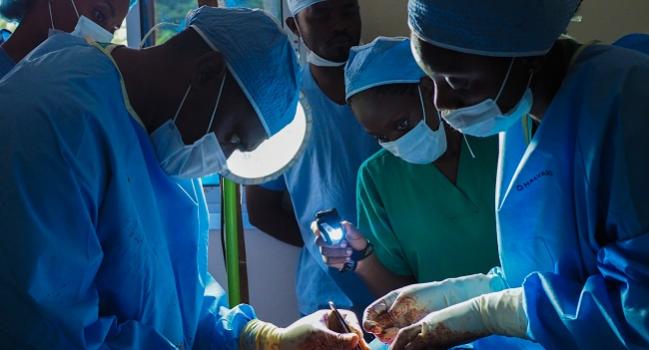‘We Have to Go to Them’: New Global Initiative for Treating Rheumatic Heart Disease
The time is now for collaborative efforts to combat rheumatic heart disease in low-to-middle-income countries, according to leading surgical societies.

Several major heart surgery organizations, as well as humanitarian and government groups, are calling for urgent action to address the treatment of rheumatic heart disease in the developing world, specifically the training of physicians and the establishment of dedicated cardiac care centers in these low-to-middle-income countries.
Rheumatic heart disease remains a significant public health problem in the developing world where it still is a major cause of cardiovascular diseases in children and young adults. Globally, rheumatic heart disease affects 33 million and kills 320,000 individuals each year. Cardiac surgery is the only effective treatment and, according to a new statement, the need for cardiac surgery in highly affected regions of low-income countries is estimated to be 300 procedures for every 1 million inhabitants.
Given the scope of the problem, the Society of Thoracic Surgeons (STS), American Association for Thoracic Surgery (AATS), Asian Society for Cardiovascular and Thoracic Surgery (ASCVS), and the European Association for Cardio-Thoracic Surgery (EACTS), as well as representatives from the Society of Cardiothoracic Surgeons of South Africa and South African Heart Association, among others, are pushing for the training of cardiac surgeons and other specialized caregivers at endorsed centers to help combat rheumatic heart disease.
“The numbers, on an epidemiologic scale, are very worrisome,” Keith Naunheim, MD (Saint Louis University Medical Center, MO), president of the STS, told TCTMD. “We know how to treat rheumatic heart disease and we know how to fix it, it’s just a question of getting the resources to the people. In its own way, it’s no different than getting vaccinations, clean water, or food to people who need it. This is every bit as lifesaving as those basic needs.”
One of the major difficulties in combating rheumatic heart disease is that while there are approximately 1 billion people living in sub-Saharan Africa (between the Maghreb and South Africa), there are just 22 cardiac centers. In Africa, for example, there is one cardiac center for every 33 million people, whereas in the US there is one cardiac clinic for every 120,000 people.
The joint statement, known as the Cape Town Declaration, was published August 3, 2018, in the Annals of Thoracic Surgery and eight other medical journals.
NGO Resources Pulled in Many Directions
To TCTMD, Naunheim said that while nongovernmental organizations (NGOs) are working hard to provide resources for the prevention and treatment of rheumatic heart disease, funding is often pulled in many different directions. For this reason, the co-authors hoped a collaborative statement from the surgical societies and others could “shine a light” on the problem and spur government and NGOs to work together to address this critical health issue.
In its own way, it’s no different than getting vaccinations, clean water, or food to people who need it. This is every bit as lifesaving as those basic needs. Keith Naunheim
The experts believe that rather than NGO “fly-in” missions, building local hospitals and training cardiac surgeons is the best solution for addressing this serious public health problem. However, a few thousand additional cardiac centers would be required to meet the unmet need, which the statement’s co-authors say is probably unrealistic. Regardless, they are calling for a “concerted effort by all stakeholders to address the plight of the poor in these regions who need cardiac surgery.”
The signatories to the Cape Town Declaration, which includes nearly 100 physicians and researchers in addition to the major cardiothoracic societies, industry representatives, regulatory agencies, legislative bodies, and charitable foundations, propose two principal aims. The first is the establishment of an international working group to evaluate and endorse the development of cardiac care in low- and middle-income countries. The second goal is to push for the training of cardiac surgeons and other specialized caregivers at these endorsed clinical centers.
“It’s a little daunting,” said Naunheim. “When they say, ‘A journey of a thousand miles begins with a single step,’ that’s where we are right now. You could look at this and say it’s just a drop in the bucket. In absolute terms, you’d be right, but I do believe we have to somehow make a decision on a government or societal level to say this is a large enough, a deadly enough problem that we need to address. It’s always a question of where do we put our resources. There is always far more need than resources throughout the world, but we think this is a worthy cause.”
Coordinated efforts between government, NGOs, medical societies, and industry could begin to establish cardiac centers in those regions most desperately in need. Industry could also play a valuable role by providing equipment at cost or cheaper than it is typically sold, said Naunheim. “We’re not going to be able to afford enough plane tickets to bring everybody to the Cleveland Clinic to get their valves replaced,” he said. “We have to go to them.”
Michael O’Riordan is the Managing Editor for TCTMD. He completed his undergraduate degrees at Queen’s University in Kingston, ON, and…
Read Full BioSources
Zilla P, Bolman RM, Yacoub MH, et al. The Cape Town Declaration on access to cardiac surgery in the developing world. Ann Thorac Surg. 2018;Epub ahead of print.
Disclosures
- Zilla and Naunheim report no conflicts of interest.


Comments